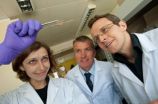(Press-News.org) PASADENA, Calif.—For many years, most scientists studying Tibet have thought that a very hot and very weak lower and middle crust underlies its plateau, flowing like a fluid. Now, a team of researchers at the California Institute of Technology (Caltech) is questioning this long-held belief and proposing that an entirely different mechanism is at play.
"The idea that Tibet is more or less floating on a layer of partially molten crust is accepted in the research community. Our research proposes the opposite view: that there is actually a really strong lower crust that originates in India," says Jean-Philippe Avouac, professor of geology and director of Caltech's Tectonics Observatory.
These insights lead to a better understanding of the processes that have shaped the Himalaya Mountains and Tibet—the most tectonically active continental area in the world.
Alex Copley, a former postdoctoral scholar with Caltech's Tectonics Observatory, along with Avouac and Brian Wernicke, the Chandler Family Professor of Geology, describe their work in a paper published in the April 7 issue of the journal Nature.
Tibet and the surrounding Himalaya Mountains are among the most dynamic regions on the planet. Avouac points out that underground plate collisions, which cause earthquakes and drive up the Himalaya and Tibet, are common geological processes that have happened repeatedly over the course of Earth's history, but are presently happening with a vigor and energy only found in that area.
Even though the elevation is uniform across the Tibetan Plateau, the type of stress seen within the plateau appears to change along a line that stretches east-west across the plateau—dividing the region into two distinct areas (southern and northern Tibet, for the purposes of this research.)
The researchers propose that a contrast in tectonic style—primarily east-west extension due to normal faulting in southern Tibet and a combination of north-south compression and east-west extension due to strike-slip faulting in northern Tibet—is the result of the Indian crust thrusting strongly underneath the southern portion of the Tibetan Plateau and locking into the upper crust. Strike-slip fault surfaces are usually vertical, and the rocks slide horizontally past each other due to pressure build-up, whereas normal faulting occurs where the crust is being pulled apart. They believe that the locked Indian crust alters the state of stress in the southern Tibetan crust, which can explain the contrast in the type of faulting seen between southern Tibet and northern Tibet.
To test their theory, the team performed a series of numerical experiments, assigning different material properties to the Indian crust. The simulations revealed evidence for a strong Indian lower crust that couples, or locks in, with the upper crust. This suggests that the "channel flow" model proposed by many geophysicists and geologists—in which a low-viscosity magma oozes through weak zones in the middle crust—¬is not correct.
"We have been able to create a model that addresses two long-standing debates," says Copley, who is now a research fellow at the University of Cambridge. "We have constrained the mechanical strength of the Indian crust as it plunges beneath the Tibetan Plateau, and by doing so have explained the variations in the types of earthquakes within the plateau. This is interesting because it gives us new insights into what controls the behavior of large mountain ranges, and the earthquakes that occur within them."
According to Wernicke, the results have motivated the team to think of ways to test further the "weak crust" hypothesis, at least as it might apply to the active tectonic system. "One way we might be able to image an extensive interface at depth is through geodetic studies of southern Tibet, which are ongoing in our research group," he says.
INFORMATION:
The Gordon and Betty Moore Foundation funded the research, described in the Nature paper, "Evidence for mechanical coupling and strong Indian lower crust beneath southern Tibet." Pembroke College in the University of Cambridge provided additional funding for Copley.
New Caltech research suggests strong Indian crust thrust beneath the Tibetan Plateau
2011-04-07
ELSE PRESS RELEASES FROM THIS DATE:
QuadTech Celebrates 20th Anniversary
2011-04-07
QuadTech (http://www.quadtech.com) a leading provider of electrical safety testers, passive component measurement solutions, ac and dc programmable power sources and dc electronic loads, is celebrating its 20th anniversary. Founder and Chairman of the Board, Phil Harris, created QuadTech in March of 1991 when he bought the Precision Instrument Division of General Radio (GenRad), an electronic test equipment manufacturer and one of the most respected names in the test and measurement industry.
While GenRad decided to focus their efforts on automatic test equipment (ATE) ...
Development of protocols for future disasters urgently called for
2011-04-07
New Orleans, LA – Dr. Howard Osofsky, Professor and Chair of Psychiatry at LSU Health Sciences Center New Orleans School of Medicine, is an author of a review article published in the April 7, 2011 issue of the New England Journal of Medicine that urgently calls for the development of protocols to deal with the health effects of disasters – before the next one occurs. One year after the largest and most devastating oil spill in United States history, the magnitude of the impact of the Deepwater Horizon Gulf Oil Spill on human health, the environment, and the economy remains ...
Research into batteries will give electric cars the same range as petrol cars
2011-04-07
Li-air batteries are a promising opportunity for electric cars. "If we succeed in developing this technology, we are facing the ultimate breakthrough for electric cars, because in practice, the energy density of Li-air batteries will be comparable to that of petrol and diesel, if you take into account that a combustion engine only has an efficiency of around 30 percent," says Tejs Vegge, senior scientist in the Materials Research Division at Risø DTU. If batteries with an energy density this great become a reality, one could easily imagine electrically powered trucks.
The ...
Minimize Foodservice Equipment Downtime and Increase Productivity by Improving the Water Quality
2011-04-07
Scheduled or unexpected equipment downtime results in lost revenue, especially if this occurs during peak hours of operation. A failed solenoid on an ice machine can shut the system down completely. De-liming a steam oven takes time--often 2-3 hours--and can require the use of harsh chemicals. If this job is outsourced, it can cost up to $75.00 or more per hour per deliming, plus scheduling arrangements and dealing with equipment that is out of commission during the cleaning.
The technical service personnel of equipment manufacturers have found that most equipment problems ...
Research identifies on-off switch for key 'factor' in heart disease and cancer
2011-04-07
Scientists at the University of Hull have identified a cellular 'on-off' switch that may have implications for treating cardiovascular disease and cancer.
The team has found the mechanism which controls the inclusion of a protein called tissue factor into endothelial microparticles, tiny vesicles which are released from cells in the lining of blood vessels.
"Although tissue factor is part of the body's natural healing process, helping create clots to stop bleeding and repair injuries, high levels circulating in the blood stream can be harmful," says lead researcher ...
Fatty liver -- how a serious problem arises
2011-04-07
Excess fat around the hips and belly may not really be compatible with current beauty ideals, but, to a certain degree, it is a normal, even vital energy store of our body. However, it is a different matter if the organism stores fat in organs such as the liver, pancreas or muscles. This is a clear sign of a metabolic disorder.
Up to 80 percent of obese people develop fatty liver disease, which is regarded a typical characteristic of the dangerous metabolic syndrome. Deposition of fat in the liver may lead to chronic liver inflammation and even to liver cancer. In addition, ...
Karlsruhe Institute of Technology: Third dimension of specific cell cultivation
2011-04-07
At Karlsruhe Institute of Technology (KIT), researchers of the DFG Center for Functional Nanostructures (CFN) succeeded in specifically cultivating cells on three-dimensional structures. The fascinating thing is that the cells are offered small "holds" in the micrometer range on the scaffold, to which they can adhere. Adhesion is possible to these holds only, not to the remaining structure. For the first time, cell adhesion and, hence, cell shape are influenced precisely in three dimensions. The team headed by Professor Martin Bastmeyer thus has achieved big progress in ...
Older age memory loss tied to stress hormone receptor in brain
2011-04-07
Scientists have shed new light on how older people may lose their memory with a development that could aid research into treatments for age-related memory disorders.
Many believe that stress is bad for our brains especially as we get older. Now researchers have shown how two receptors in older brains react to a stress hormone called cortisol, which has been linked to increasing forgetfulness as we age.
The study, by the University of Edinburgh, found that one receptor was activated by low levels of cortisol, which helped memory.
However, once levels of this stress ...
Researchers develop golden window electrodes for organic solar cells
2011-04-07
Researchers at the University of Warwick have developed a gold plated window as the transparent electrode for organic solar cells. Contrary to what one might expect, these electrodes have the potential to be relatively cheap since the thickness of gold used is only 8 billionths of a metre. This ultra-low thickness means that even at the current high gold price the cost of the gold needed to fabricate one square metre of this electrode is only around £4.5. It can also be readily recouped from the organic solar cell at the end of its life and since gold is already widely ...
Long-term users of ecstasy risk structural brain damage
2011-04-07
Long term users of the popular recreational drug ecstasy (MDMA) risk structural brain damage, suggests preliminary research published online in the Journal of Neurology, Neurosurgery and Psychiatry.
Other research has suggested that people who use ecstasy develop significant memory problems, so the Dutch researchers wanted to find out if there was any clinical evidence of structural changes in the brain to back this up.
They focused on the hippocampus, which is the area of the brain responsible for long term memory.
They measured the volume of the hippocampus using ...




